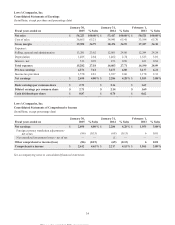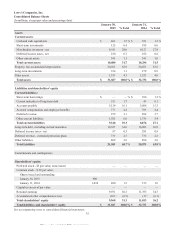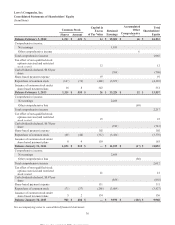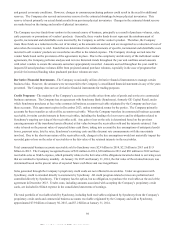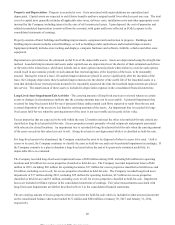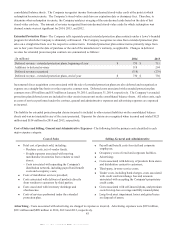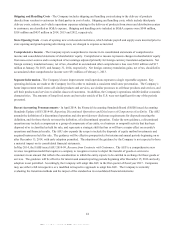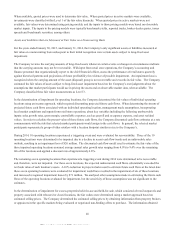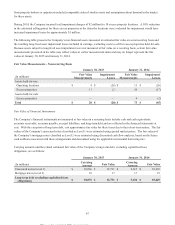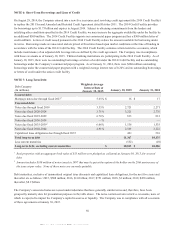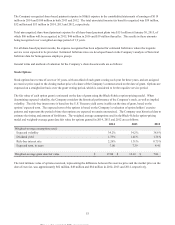Lowe's 2014 Annual Report Download - page 54
Download and view the complete annual report
Please find page 54 of the 2014 Lowe's annual report below. You can navigate through the pages in the report by either clicking on the pages listed below, or by using the keyword search tool below to find specific information within the annual report.Shipping and Handling Costs - The Company includes shipping and handling costs relating to the delivery of products
directly from vendors to customers by third parties in cost of sales. Shipping and handling costs, which include third-party
delivery costs, salaries, and vehicle operations expenses relating to the delivery of products from stores and distribution centers
to customers, are classified as SG&A expense. Shipping and handling costs included in SG&A expense were $548 million,
$501 million and $457 million in 2014, 2013 and 2012, respectively.
Store Opening Costs - Costs of opening new or relocated retail stores, which include payroll and supply costs incurred prior to
store opening and grand opening advertising costs, are charged to expense as incurred.
Comprehensive Income - The Company reports comprehensive income in its consolidated statements of comprehensive
income and consolidated statements of shareholders' equity. Comprehensive income represents changes in shareholders' equity
from non-owner sources and is comprised of net earnings adjusted primarily for foreign currency translation adjustments. Net
foreign currency translation losses, net of tax, classified in accumulated other comprehensive loss were $103 million and $17
million at January 30, 2015, and January 31, 2014, respectively. Net foreign currency translation gains, net of tax, classified in
accumulated other comprehensive income were $51 million at February 1, 2013.
Segment Information - The Company’s home improvement retail operations represent a single reportable segment. Key
operating decisions are made at the Company level in order to maintain a consistent retail store presentation. The Company’s
home improvement retail stores sell similar products and services, use similar processes to sell those products and services, and
sell their products and services to similar classes of customers. In addition, the Company's operations exhibit similar economic
characteristics. The amounts of long-lived assets and net sales outside of the U.S. were not significant for any of the periods
presented.
Recent Accounting Pronouncements - In April 2014, the Financial Accounting Standards Board (FASB) issued Accounting
Standards Update (ASU) 2014-08, Reporting Discontinued Operations and Disclosures of Components of an Entity. The ASU
amends the definition of a discontinued operation and also provides new disclosure requirements for disposals meeting the
definition, and for those that do not meet the definition, of a discontinued operation. Under the new guidance, a discontinued
operation may include a component or a group of components of an entity, or a business or nonprofit activity that has been
disposed of or is classified as held for sale, and represents a strategic shift that has or will have a major effect on an entity's
operations and financial results. The ASU also expands the scope to include the disposals of equity method investments and
acquired businesses held for sale. The guidance will be effective prospectively for interim and annual periods beginning on or
after December 15, 2014, with early adoption permitted. The adoption of the guidance by the Company is not expected to have
a material impact on its consolidated financial statements.
In May 2014, the FASB issued ASU 2014-09, Revenue from Contracts with Customers. The ASU is a comprehensive new
revenue recognition model that requires a company to recognize revenue to depict the transfer of goods or services to
customers in an amount that reflects the consideration to which the entity expects to be entitled in exchange for those goods or
services. The guidance will be effective for interim and annual reporting periods beginning after December 15, 2016 and early
adoption is not permitted. Accordingly, the Company will adopt this ASU in the first quarter of fiscal year 2017. Companies
may use either a full retrospective or a modified retrospective approach to adopt this ASU. The Company is currently
evaluating the transition methods and the impact of the standard on its consolidated financial statements.
44
This proof is printed at 96% of original size
This line represents final trim and will not print


